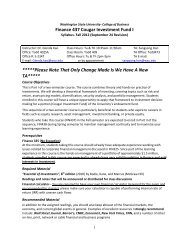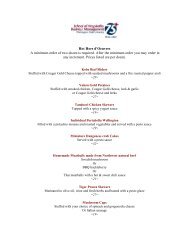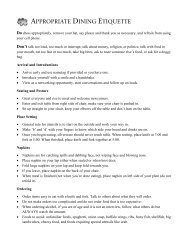Hospitality Business Management: - College of Business ...
Hospitality Business Management: - College of Business ...
Hospitality Business Management: - College of Business ...
You also want an ePaper? Increase the reach of your titles
YUMPU automatically turns print PDFs into web optimized ePapers that Google loves.
ig-name, national companies that<br />
one might assume would know<br />
better—don’t always do enough<br />
research when creating or redesigning<br />
the images that represent them.<br />
“Where they sometimes really miss<br />
the mark is in their mark, in their<br />
logos,” she says.<br />
The telecommunications company<br />
AT&T, for example, recently changed<br />
its highly recognizable, all-capital-letter<br />
logo and blue-and-white-striped<br />
circle to more informal, thinner,<br />
lowercase letters next to a sphere that<br />
looks like a bouncing ball.<br />
“AT&T has wanted to look like<br />
they’re more approachable,” Henderson<br />
says. The new logo “is definitely<br />
more approachable, but where they<br />
fall short is that they don’t know how<br />
multidimensional their font is.”<br />
That is, the fonts that companies<br />
choose in their marketing can convey<br />
different messages: confidence,<br />
distrust, pleasure, reassurance,<br />
strength, coldness, and more. AT&T’s<br />
prior font was bold, giving it a feeling<br />
<strong>of</strong> strength and stability, while the<br />
new font is thinner and more casual.<br />
In April 2005, Henderson published<br />
an article in the Harvard <strong>Business</strong><br />
Review that advises marketers to<br />
consider the messages sent—either<br />
intentionally or not—by their<br />
typeface. Henderson, along with CB<br />
pr<strong>of</strong>essors Joan Giese and Joseph<br />
Cote, studied 210 typefaces.<br />
Fonts that subjects considered<br />
warm, attractive, likable, and feminine<br />
include AncientScript, Enviro,<br />
and Informal Roman. The downside<br />
<strong>of</strong> using those fonts is that they aren’t<br />
especially strong or reassuring.<br />
Fonts that might be effective in an<br />
edgy marketing campaign because<br />
they’re considered interesting,<br />
emotional, exciting, and innovative<br />
are Chiller, Stonehenge, and Paintbrush.<br />
A business trying to convey<br />
feelings <strong>of</strong> assurance and strength,<br />
such as a bank, might want to avoid<br />
using those fonts since study subjects<br />
felt those options were unsettling and<br />
unfamiliar, Henderson says.<br />
The third group includes Playbill,<br />
Onyx, and StencilSet, fonts that<br />
were called cold, unattractive, and<br />
unemotional by the study subjects.<br />
So should marketers avoid those<br />
unfriendly typefaces altogether?<br />
“These typefaces aren’t useless,”<br />
Henderson says in the article. “Companies<br />
might, for example, use them<br />
to display characteristics or claims<br />
<strong>of</strong> a countercultural or competing<br />
brand.”<br />
Advertising Scholar Receives<br />
Lifetime Achievement Award<br />
The article goes on to identify<br />
strong, masculine fonts, such as<br />
NewYorkDeco and Fisherman;<br />
interesting and emotional—yet<br />
dishonest—fonts, such as BigDaddy<br />
and Ransom; and commonly used<br />
fonts that project stability, such as<br />
Georgia and Times New Roman.<br />
Darrel Muehling, pr<strong>of</strong>essor and chair <strong>of</strong> the Department<br />
<strong>of</strong> Marketing, was honored with a lifetime<br />
achievement award for outstanding contribution to<br />
advertising research from the American Academy <strong>of</strong><br />
Advertising (AAA) in March.<br />
Only 14 people have received this award since the<br />
AAA was founded in 1958. The Academy publishes<br />
the Journal <strong>of</strong> Advertising and serves the industry by<br />
strengthening advertising research and education.<br />
According to the AAA, “Darrel has made major<br />
contributions to advertising research over his career, including several best paper<br />
awards at leading journals like the Journal <strong>of</strong> Advertising. Darrel is past president<br />
<strong>of</strong> AAA and has been cited as one <strong>of</strong> the most frequent contributors to the top<br />
journals <strong>of</strong> our field.”<br />
“I have always been interested in why or how advertising works,” says<br />
Muehling. He teaches a class on the principles <strong>of</strong> marketing for juniors, and<br />
a senior-level promotions management course that provides a text and case<br />
approach to integrating promotion into the marketing plan by examining<br />
methods, organization, communications, media selection, and campaigns.<br />
After earning his bachelor <strong>of</strong> science, bachelor <strong>of</strong> arts, master’s, and doctorate<br />
degrees from the University <strong>of</strong> Nebraska, Muehling joined the WSU marketing<br />
faculty in 1985. He became an associate pr<strong>of</strong>essor with tenure in 1991, and full<br />
pr<strong>of</strong>essor in 1997, the same year he assumed leadership <strong>of</strong> the department. He<br />
has developed courses for distance degree students, was a visiting pr<strong>of</strong>essor at<br />
Thammasat University and Prince <strong>of</strong> Songkla University in Thailand, and has<br />
served on numerous university, college, and industry committees.<br />
Dividend 15












